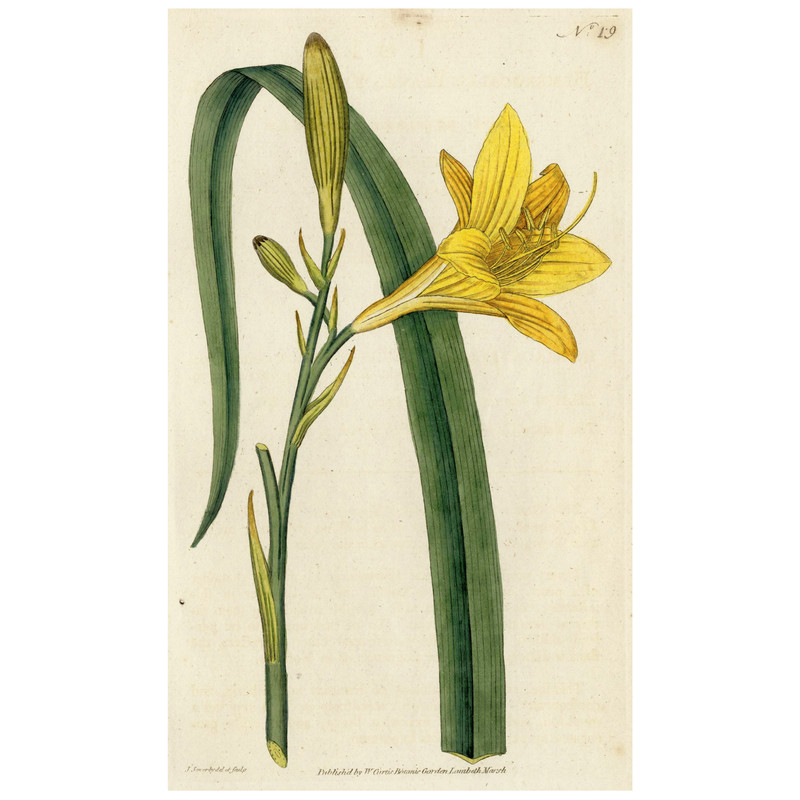Scarce 1787 First Edition Hand-Colored Copperplate Botanical Engraving from:
CURTIS'S
BOTANICAL MAGAZINE
OR,
Flower-Garden Displayed:
No. 19
HEMEROCALLIS FLAVA.
YELLOW DAY-LILY.
(Hemerocallis lilioasphodelus)
Lemon Daylily, Lemon Lily,
Yellow Daylily)
This the 19th plate from the very first volume. It's one of the greatest of the early, iconic classic engravings from "The Botanical Magazine; or Flower-Garden Displayed". It's printed on the Chain-Lined, Laid paper which most likely indicates a First Edition print. It's in remarkably pristine, undamaged condition.
These gems from the early Curtis volumes have become extremely rare, nearly un-findeable it seems. Apparently their persistent popularity & famed excellence has drained the limited supply of these handmade magnificent works. I find no other original copies of this plate anywhere at present.
The Publication:
The "Botanical Magazine" was first published in 1787 by William Curtis (1746-1799). After William Curtis passed, the magazine was published by his brother, Thomas Curtis. Later, Samuel Curtis (a son-in-law of William Curtis) became proprietor from 1801 to 1845. The prints in the first volumes were copper plates colored by hand. Some of the later prints were lithographs.
Some of the distinguished artists were Sydenham Edwards, John Curtis, William Jackson Hooker, W.H. Fitch, William Graves and Matilda Smith. These prints have a universal beauty and are a lasting documentary contribution to botanical studies.
The Artist:
Sydenham Teast (or Teak) Edwards (1768 – 1819) was a natural history illustrator. He illustrated plants, birds and importantly published an illustrated book on the breeds of dogs in Britain, Cynographia Britannica.
Young Edwards had a precocious talent for draughtsmanship and when only 11 years old had copied plates from Flora Londinensis for his own enjoyment. A certain Mr. Denman visited Abergavenny in 1779 and saw some of Edwards' work. Denman, being a friend of William Curtis, the publisher of botanical works, and founder of the Curtis's Botanical Magazine, spoke to Curtis about the boy. Curtis proceeded to have Edwards trained in both botany and botanical illustration.
Edwards produced plates at a prodigious rate: between 1787 and 1815 he produced over 1,700 watercolors for the Botanical Magazine alone. He illustrated Cynographia Britannica (1800) (an encyclopaedic compendium of dog breeds in Britain), New Botanic Garden (1805-7), New Flora Britannica (1812), and The Botanical Register (1815-19). Edwards established the latter under his own editorship in 1815 after a disagreement with John Sims, who succeeded Curtis as editor. He also provided drawings for encyclopedias such as Pantologia and Rees's Cyclopædia. He completed a number of parrot illustrations between 1810 and 1812 which were acquired by Edward Smith-Stanley, 13th Earl of Derby. Edwards was elected a Fellow of the Linnean Society in 1804.
The Plates:
The delicate drawing & coloring are quite stunning. These are famously beautiful plates, full of the passion that the early flower painters, botanists & gardeners had for these amazing flowers, many of which were discovered in the pristine reaches of the ever-expanding British Empire & by intrepid explorers of the time.
These gorgeously drawn, engraved & water-colored original prints were presented on their page with consistently balanced, beautiful compositions.
Every part of these prints was made by hand: Hand drawn & engraved on Copper which was hand-mined, smelted & rolled, printed onto handmade cotton rag paper, inked & colored with hand-ground pigments individually by hand, & they were usually hand sewn into handmade leather-bound books.
Condition: Appears to be in excellent condition with characteristic light age-toning to the paper. The hand-coloring appears to remain sharp & brilliant as the day it was painted.
Condition:
Appears to be in excellent condition for a nearly 220-year-old engraving. Minor age-toning & antiquarian character as is typical. Patch of foxing at extreme right margin along bound edge, not encroaching on plate-mark. These prints are very old & may have minor imperfections expected with age, such as some typical age-toning of the paper, oxidation of the old original watercolors, spots, text off-setting, artifacts from having been bound into a book, etc. They are handmade & each has its own unique variations. Please examine the photos & details carefully.
Text Page(s): This one comes with its original text page(s), beautifully hand typeset in the old English on handmade paper.
Size: 9 x 5-1/2 inches approximately.












